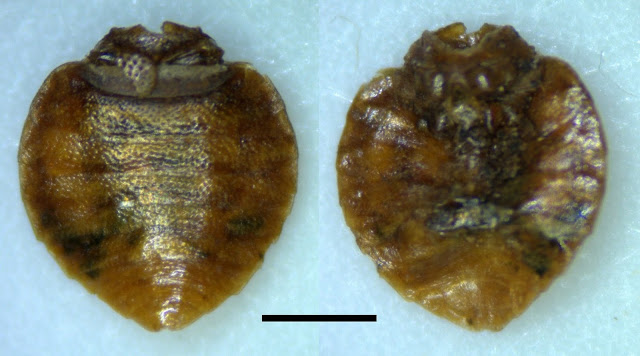A cave in southern Oregon that is the site of some the oldest preserved evidence of human activity in North America was also once home to not-too-distant cousins of the common bed bug.
Journal of Medical Entomology, a pair of archaeologists describe remains found in caves near Paisley, Oregon, that represent the oldest specimens of insects from the genus Cimex ever found, ranging between 5,100 and 11,000 years old.
The remains were identified as relatives of the bed bug, Cimex lectularius, but they were "not the bed bug we all know and love from hotel rooms," says Martin E. Adams of Paleoinsect Research and co-author on the study with Dennis L. Jenkins of the Museum of Natural and Cultural History at the University of Oregon. The species in the Paisley Five Mile Point Caves (Cimex pilosellus, Cimex latipennis, and Cimex antennatus) are all parasites of bats.
 |
| The abdomen of a female Cimex pilosellus found in the Oregon cave [Credit: Martin E. Adams/Paleoinsect Research] |
Cimex lectularius and Cimex hemipterus are the two bed bug species that are known to parasitize humans, widely believed to have adapted to that role thousands of years ago when humans shared caves with bats in Europe, Asia, and Africa. The species found in the Oregon caves, however, never made that jump, and Adams says it's unclear why not.
 |
| The Cimex antennatus specimen dated back 5,100 years, while others ranged from 9,400 to nearly 11,000 years old [Credit: Martin E. Adams/Paleoinsect Research] |
The identification of the three Cimex species may also offer some clues to climactic trends during the eras they were dated to, Adams says. Cimex antennatus, for instance, tends to favor the warmer climates of California and Nevada. "The presence of warm-tolerant cimicids in the caves, such as Cimex antennatus, may suggest that climatic conditions at Paisley Caves 5,100 years ago were similar to what Cimex antennatus enjoys today in its current range."
Source: Entomological Society of America [April 04, 2017]







0 komentar:
Post a Comment